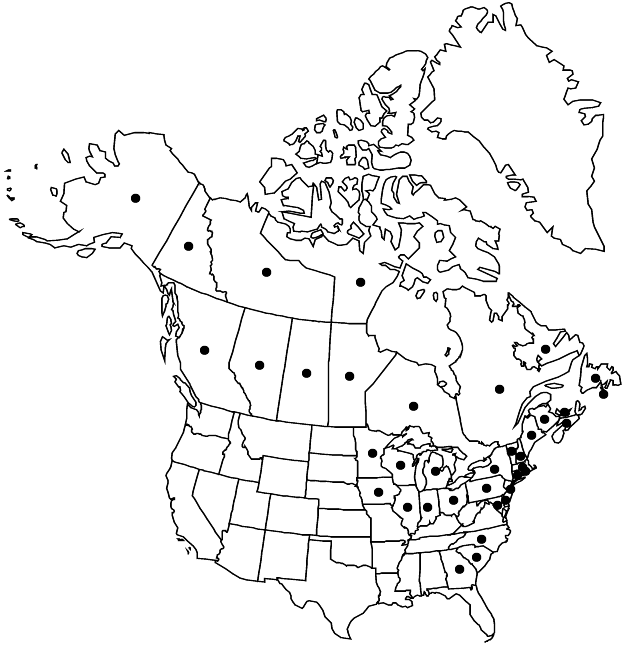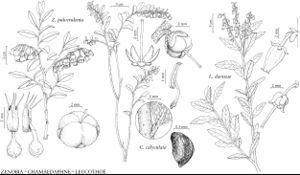Chamaedaphne calyculata
Methodus, 457. 1794,.
Shrubs much-branched, 0.2–1.5 m; twigs fulvous; buds with outer scales. Leaves: petiole 1.5–3 mm; blade dull olive green, dark green adaxially, (1–)1.5–5 × 1–1.5 cm, gradually smaller in leafy raceme, proximal mature leaves 3 times as long as wide, base cuneate, apex obtuse or acute, mucronulate, surfaces yellowish-lepidote, densely so abaxially, adaxial midvein lanulose. Inflorescences pendent, 4–12 cm. Pedicels 2–5 mm, densely hairy; bracteoles persistent in fruit, 2, in apices of pedicels, imbricate, margins ciliate, abaxial surface lepidote. Flowers: sepals persistent in fruit, 1.5–3 mm, 1/2 as long as to equaling capsule, 1/3–1/2 times as long as corolla, apex acute or acuminate, margins ciliate, abaxial surface lepidote; corolla 5–7 mm, lobes imbricate in bud, spreading to recurved, ovate, glabrous; nectariferous disc 10-lobed from ovary base to between stamen filaments. Capsules 3–4(–5) mm diam., glabrous; epicarp 5-valved, separating from 10-valved endocarp. Seeds golden brown, 1 mm. 2n = 22.
Phenology: Flowering Apr–Jul; fruiting Jul–Aug.
Habitat: Boreal and subarctic peatlands, margins of boggy swamps and streams in coniferous forests, pocosins in coastal plain, often forming dense thickets
Elevation: 0-1300 m
Distribution

St. Pierre and Miquelon, Alta., B.C., Man., N.B., Nfld. and Labr., N.W.T., N.S., Nunavut, Ont., P.E.I., Que., Sask., Yukon, Alaska, Conn., Del., Ga., Ill., Ind., Iowa, Maine, Md., Mass., Mich., Minn., N.H., N.J., N.Y., N.C., Ohio, Pa., R.I., S.C., Vt., Wis., Eurasia.
Discussion
Some flowers of Chamaedaphne calyculata have both stamens and ovaries functional, others have either ovaries or anthers with aborted contents (B. F. Palser 1951). Flower buds produced on leafy shoots in the first year mature, but the buds do not open until the following spring. If snow cover is sufficient to protect the buds, they will survive to blossom early and produce seed by midsummer, after 1.5 growing seasons. Wind, rain, or passing animals shake mature seeds out of slits in the dry, dehiscent capsule.
Although Chamaedaphne calyculata is widespread in North America, it is critically imperiled or threatened in Illinois and Maryland and imperiled or vulnerable in its range in northeastern British Columbia, Ohio, North Carolina (now nearly extirpated in the mountains, known from a single bog of less than one hectare). Its presence in Iowa and Georgia remains unconfirmed by modern herbarium specimens; it is considered extirpated. Chamaedaphne shows a disjunct distribution in the mountains of North Carolina, and to the coastal plain of North Carolina and northeastern South Carolina. The southern occurrences are certainly relicts of more southerly Pleistocene distributions.
Three varieties (the Eurasian var. calyculata, var. latifolia in maritime Canada and northern New England, and the widespread var. angustifolia), appearing in some floras (M. L. Fernald 1950; H. J. Scoggan 1978–1979; F. C. Seymour 1982), were distinguished based on slight variations in the sizes and shapes of leaves and sepals. These and the diminutive var. nana are popular as cultivated ornamentals, but their taxonomic validity awaits detailed examination and they have not been recognized in most recent treatments.
Some native groups reportedly used the leaves of Chamaedaphne calyculata for tea; the plants contain andromedotoxin, which can be fatally poisonous (J. M. Kingsbury 1964).
Selected References
None.
